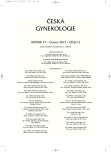Lymphatic mapping in axilla as possible prevention of lymphedema in breast cancer patients – first results of the anatomical study
Authors:
D. Pavlišta
; O. Eliška
Authors‘ workplace:
Gynekologicko-porodnická klinika1. LF UK a VFN, Praha. přednosta prof. MUDr. A. Martan, DrSc.
Published in:
Ceska Gynekol 2012; 77(3): 251-254
Overview
Objective:
Lymphatic mapping is a method to find and preserve upper extremity lymphatics during axillary surgery (axilla clearance and sentinel node biopsy) in breast cancer patients. This may reduce the incidence of lymphedema. We examined on anatomical model, if the lymphatic drainage of the upper extremity is fully separable from the lymphatic drainage of the breast. We further endeavored to find an explanation as to why lymphedema occurs in the upper extremity after sentinel node biopsy in breast carcinoma.
Design:
Pilot study.
Setting:
Oncogynecologic Center, Department of Obstetrics and Gynecology, First Faculty of Medicine, Charles University in Prague and General University Hospital, Prague.
Methods:
Patent blue dye was injected deep and superficially in arm and breast bilaterally in 9 cadavers. After visualization and precise dissection of the lymphatic vessels and nodes, a record of their routes was made. A scheme of arm and breast lymphatics was constructed.
Results:
The lymph from arm is drained by 2–4 main afferent collectors. As opposed to cranial and medial collectors, caudal collectors diverged from the axillary vein and entered the caudal axilla. In one case the caudal collector entered a node, which was considered to be the sentinel node of the breast. The other important finding is the demonstration of lymphatic anastomoses that take place between imaged nodes in the caudal axilla, which is the most frequent localization of the breast sentinel lymph node.
Conclusion:
The relationship of lymphatic drainage of the arm and breast are closely related and share connections. These connections represent the main problem, which could explain lymphedema following surgery if damaged. Further studies are necessary to improve understanding of this method and to increase the number of observations.
Key words:
axillary reverse mapping, breast cancer, lymphedema, sentinel node biopsy.
Sources
1. Boneti, C., Korourian, S., Diaz, Z., et al. Scientific Impact Award: Axillary reverse mapping (ARM) to identify and protect lymphatics draining the arm during axillary lymphadenectomy. Am J Surg, 2009, 198, 4, p. 482–487.
2. Casabona, F., Bogliolo, S., Valenzano, M., et al. Feasibility of axillary reverse mapping during sentinel lymph node biopsy in breast cancer patients. Ann Surg Oncol, 2009, 16, 9, p. 2459–2463.
3. Clough, B., Nasr, R., Nos, C., et al. New anatomical classification of the axilla with implications for sentinel node biopsy. Br J Surg, 2010, 97, 11, p. 1659–1665.
4. Eliška, O., Teisinger, P. Možnosti kolaterální cirkulace lymfatických cév axily v RTG obraze. Čs Radiol, 1976, 30, 3, s. 145–152.
5. Gerber, L., Lampert, M., Wood, C., et al. Comparison of pain, motion, and edema after modified radical mastectomy versus local excision with axillary dissection and radiation. Breast Cancer Res Treat, 1992, 21, 2, p. 139–145.
6. Giuliano, A., Hunt, K., Ballman, K., et al. Axillary dissection vs no axillary dissection in women with invasive breast cancer and sentinel node metastasis: a randomized clinical trial. JAMA, 2011, 305, 6, p. 569–575.
7. Kiel, K., Rademacker, A. Early-stage breast cancer: Arm edema after wide excision and breast irradiation. Radiology, 1996, 198,1, p. 279–283.
8. Klimberg, S. A new concept toward the prevention of lymphedema: axillary reverse mapping. J Surg Oncol, 2008, 97, 7, p. 563–564.
9. Noguchi, M. Axillary reverse mapping for breast cancer. Breast Cancer Res Treat, 2010, 119, 3, p. 529–535.
10. Noguchi, M. Axillary reverse mapping for breast cancer. Breast Cancer Res Treat, 2010, 119, 3, p. 529–535.
11. Schrenk, P., Rieger, R., Shamiyeh, A., Wayand, W. Morbidity following sentinel lymph node biopsy versus axillary lymph node dissection for patients with breast carcinoma. Cancer. 2000, 88, 3, p. 608–614.
12. Thompson, M., Korourian, S., Henry-Tillman, R., et al. Axillary reverse mapping (ARM): A new concept to identify and enhance lymphatic preservation. Ann Surg Oncol, 2007, 14, 6, p. 1890–1895.
13. Wilke, G., McCall, M., Posther, E., et al. Surgical complications associated with sentinel lymph node biopsy: results from a prospective international cooperative group trial. Ann Surg Onco, 2006,13, 4, p. 491–500.
Labels
Paediatric gynaecology Gynaecology and obstetrics Reproduction medicineArticle was published in
Czech Gynaecology

2012 Issue 3
Most read in this issue
- Impact of oxidative stress on male infertility
- Peripartal hysterectomy – review
- The influence of maternal age, parity, gestational age and birth weight on fetomaternal haemorrhage during spontaneous delivery
- Sever bleeding one year after a cesarean section caused by placenta increta persistens
